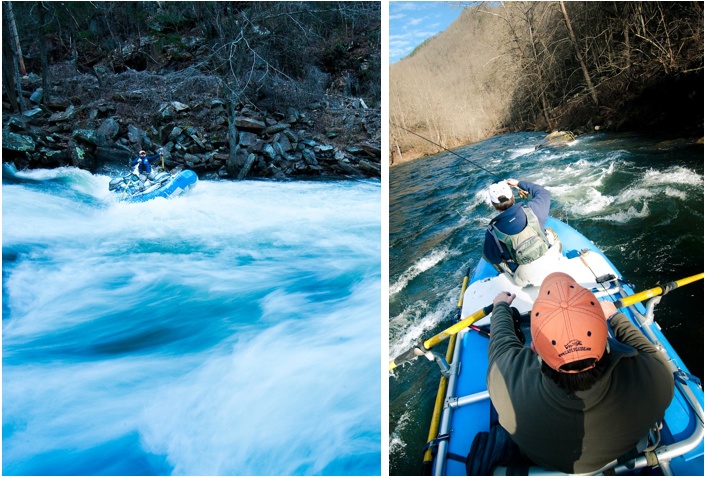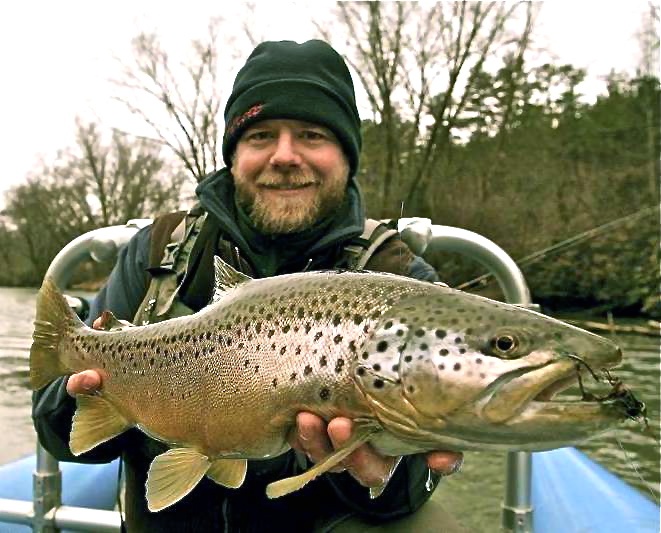It’s really hard to beat streamer fishing high water on tailwater’s from a drift boat, especially when your wanting to target trophy class fish.
Although numbers of trout caught during high water flows usually are lower than fishing during low water flows, the size of your catches generally are much larger. In my opinion, the biggest fish in the river prefer to feed during high water because it’s easy for them to ambush their prey, and they feel camouflaged and protected by the high water flows.
For those of you that fish tailwater’s you probably understand water flows change significantly during generation and non-generation periods. Some tailwaters during minimum flow periods have water releases under 100 cubic feet of water per second (CFS), and when generation is taking place, water flows can be 10-20 times higher. Because of this, it’s very important for anglers fishing high water to outfit themselves correctly, otherwise they may find themselves coming off the water fish-less. Below are some tips and strageties I use on tailwaters when I’m fishing high water conditions.
Tip 1. Leave your 4-5 weight fly rods at home and pack your 7-9 weight fly rods.
Your best bet for going after the big boys during high water flows is fishing streamers. There are some tailwater’s out there where you can still dry fly and nymph fish effectively, but most of the time, if you want to target the largest trout in the river, you’ll want your flies to imitate the larger food sources. Some examples of these food sources are: sculpins, daces, crayfish, and fingerling size trout. These guys are the food choices that trophy class fish prefer to hunt down and forage on during high water flows. Since you’ll be fishing a variety of sinking fly lines and large profile streamer patterns on the water, outfitting yourself with a fly rod in the 7-9 weight range will cut down on your fishing fatigue and allow you to cast much more efficiently. High water streamer fishing is demanding on the fly angler, and ideally, you want to be able to make one or two false casts between presentations.
Tip 2. Spool up these two types of fly lines for high water.
When I’m fishing high water on tailwater’s, I primarily fish two types of fly lines. The first fly line I have rigged is a clear intermediate fly line. I prefer to fish this type of fly line when I’m working stretches of the river where it’s really wide and shallow. Fishing full sinking lines in this situation will wear you out, period. You’ll find the super fast retrieve that’s required to keep your streamers from snagging the bottom constantly, will not be efficient or effective. Fishing an intermediate fly line paired with a wiggle minnow style streamer can be deadly. Long steady strips will provide your best action with these types of streamers, but don’t make the mistake of not dead drifting them between strips occasionally. I’ve had lots of big fish eat my wiggle minnow on the dead drift.
My second fly line I use is a full sinking fly line from 250-350 grains. A full sinking line really shines for keeping your streamers deep in the water column during your quick retrieves. It’s great when your pounding the banks and stripping back to the boat, but more importantly, it’s critical for getting hookups when your swinging your streamers through a deep run or pool. If you’re not fishing full sinking fly lines in deep water most of the time you won’t be getting your fly down in the strike zone and keeping it there.
Tip 3. Choose the right streamers for high water.
Choose streamer patterns that have good movement in the water. Tying materials like marabou, rabbit, and rubber legs provide life-like swimming motion and should be incorporated into your streamers. I also like my streamers to have big heads tied with either wool, polar fiber, or deer hair. Streamers with big heads push a lot of water when stripped, and quite often, it’s a key attribute that big fish look for when foraging on larger prey. Articulated streamers will add further movement, and although it’s not always necessary to fish them, I strongly believe they produce more strikes day in and day out. Load your fly boxes with streamers 2 1/2 – 5″ in length. Some days the fish will prefer a smaller streamer, while other days the larger flies will be the only thing that will convince the big boys to eat. I really like fishing bi-color or two toned streamers. You’ll find most prey is multi-colored anyway, but fishing a two tone colored streamer may help you dial into what color the fish are preferring more during your fishing. I also like to use big eyes on my streamers when possible because most forage prey have them, but they seem to make the flies look that much more realistic. Lastly, make sure you have weighted and unweighted versions of your favorite streamer patterns. Unweighted patterns often have a little more action in the water, but sometimes you’ll find them to be difficult to get down quick enough when you’re fishing eddies and pockets in fast water.
Tip 4. Find the fish and then work them thoroughly.
Fishing high water can sometimes be very challenging for anglers to find fish. You will regularly fish large stretches without bites. When you do get a bite or land a fish I recommend you try to anchor when possible, and fish the area more thoroughly. A productive section of water can hold multiple trophy size fish. Anglers need to understand that high water encourages fish to move into places where they can feed effectively and find refuge out of the calorie burning high water current. Concentrate on fishing banks with good amounts of wood or boulders. They provide current breaks and ambush points for big fish. You should also search out deep seams where fast water meets slow water. A good example of this is where a tree has fallen in the river creating a well defined current seam or a big boulder or shoal. When you find shallow water transitioning into deep water, fish it. Gravel bar ledges and buckets downstream of shoals are also very productive spots for big fish. The key to consistent success when fishing high water on tailwater’s is putting in the time to learn the water. Be prepared for low catch rates when you’re starting out. You’re going to have to locate the hotspots on the river, and that’s going to take time. On the upside, when you’ve done your homework and your high water streamer fishing gets dialed in, you can have epic big fish days on the water.
Kent Klewein Gink & Gasoline www.ginkandgasoline.com hookups@ginkandgasoline.com Sign Up For Our Weekly Newsletter!



I would suggest to NEVER EVER throw a streamer at anytime on the stream if you haven’t before. You will be ruined for life. The strike from a fish on a streamer is the most awesomely violent thing you will ever see on a stream. I constantly find myself looking at water and fighting back the urge to fish some type of streamer pattern. Just let your buddy fish and row the boat instead if you can.
These tips should be published in a book somewhere…the advise combined with the photography are top notch.
That pic of Raul is bad-ass.
Pingback: High Water Streamer Fishing in Tailwaters | MidCurrent
Hey Kent,
I am in Maine looking to fish tomorrow and was doing some research on the water I want to choose and came across a repost of your post here… kinda cool how far your name and site reaches these days.
http://www.saddlebackmaine.com/flyfishinginmaine
btw it’s about 3/4 down the page on the left side under fly fishing news.
Chris,
Man I wish I was fishing with you in Maine right now. Hope you have a great Thanksgiving and catch some nice fish. Also, thanks for pointing out that link, that is pretty cool.
Kent
Pingback: Gink and Gasoline says: | Time Flies by Oskar
I have a stiff 9.5 Orvis helios 2 …Is this a stiff enough rod to throw streamers….